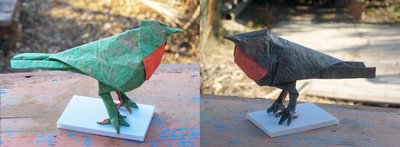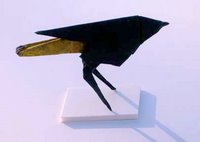But there is no need for dreadful anticipations. As we speak, out there on the edge of the universe, in Calgary, Canada, Roman Diaz is plugging away at his Birds: carrying the study of avian origami to what I think everyone will recognize as new heights. His bird from the post before last (Nov 1 2006) is not so much a homage to Michael LaFosse’s Cardinal as a rival to it, in elegance of straight-line form and color (if not in simplicity of design), something I would scarcely have imagined possible. And in the ‘Calandria’ of the last post (Nov 9) there is more improvement still: this time on the rounded form of the bird. --All of which personally would be an unmitigated joy were it not for the fact I’d staked out some of this field for myself, once upon a time. I am not yet ready to cede at least partial ownership of it. Not without a fight anyway. I don’t mind losing but not quite so easily...
Let us pick nits. Roman says, if my feeble Spanish is getting it right: (a) very many birds in origami are indeed made from the Bird Base; and (b) without using High Technology, a standing bird with wings folded on its back will not show two distinct wings, but only one conjoined surface, if made from the Bird Base or any of the other traditional bases.
As to (a): I’m not at all sure this is factually true. We may have to consult the Origami Database (supposing it somewhere contains the useful category of bases a model was designed from) to see how many birds really are made from the Bird Base as a share of the total. The term itself certainly did not originate from any such preponderance of designs, any more than the ‘Fish Base’ is so called because most or even many fish derive from it (of that I’m surer: they don’t). Presumably only one bird ever gave rise to the term ‘Bird Base’—the Crane. Historians are of course invited to do their stuff here.

When I set out last year to show an assortment of ‘Bird-Based birds’ of my own design it was not because this seemed an especially natural or widespread thing for model-makers to do; the point was rather to show that there was life in this tired old base still, and that models of considerable purity and power can be made from familiar beginnings and relatively low technologies. (Dare to be ridiculously simple, stupid and obvious, my motto seems to be.) I was annoyed in particular by the birds Robert Lang had displayed at Barcelona (2005), which took over 50 steps to make; a few trials over the years had suggested that slightly simpler, but just as effective birds ought to be makeable in no more than 10 to 15 steps--or say 20 if you point-split feet, which isn’t always an improvement.
But having considered the matter further, it now seems to me that the Bird Base really is a natural beginning for birds, standing ones especially—even ones with substantial amounts of detail. That’s because it puts the points in all the right places and leaves them pretty much
 independent. If you want to add details that cost you limb length (e.g. point-split feet), you can always compensate by shortening the other elements proportionately (ideally adding detail there too). This then yields a design virtue I try to get from all of my own origami: something we may call ‘continuous-complexifyability.’ (Ugh. Ugh!) That is: a design should yield good enough results in its most simple format, but also be able to sustain gradual increments of complexity or detail, if that’s desired, without modifying the superstructure. The ideal would be for Roman’s useful ‘progression of bird complexity’ illustration to be the literal truth about adding details to the same model (or barring that, to the same concept). With a Bird Base, that is almost possible.
independent. If you want to add details that cost you limb length (e.g. point-split feet), you can always compensate by shortening the other elements proportionately (ideally adding detail there too). This then yields a design virtue I try to get from all of my own origami: something we may call ‘continuous-complexifyability.’ (Ugh. Ugh!) That is: a design should yield good enough results in its most simple format, but also be able to sustain gradual increments of complexity or detail, if that’s desired, without modifying the superstructure. The ideal would be for Roman’s useful ‘progression of bird complexity’ illustration to be the literal truth about adding details to the same model (or barring that, to the same concept). With a Bird Base, that is almost possible.As to (b), the point about folded separate wings: As a generalization that may be true. But it also depends on what you consider to be the ‘Traditional Bases’ and what you take to be ‘High Technology’. (OK, so Roman did not use this term.)

For instance, here’s a picture of an actual 1987 model, the ‘Fat Pigeon’. It’s from a Stretched Blintzed Bird-Base. Does that count as a “traditional base? The technology is pretty ‘traditional’ too, i.e. practically obsolete, though in ‘87 it was state-of-the-art.
For the record, about six months ago I simplified this model (abandoning legs altogether) and made a version from a plain old stretched Bird Base. Here it is. This modification follows two
 design principles, the first one tried and true—“KISS”, or, ‘Keep It Simple, Stupid’—the second more theoretical and unproven: “POETIC”, or ‘Put Opposite Elements Together, Idiot, in Combinations.’ (yeah I just made this up.) Here the ‘combination’ is of 3D/rounded form with 2D and even 1-D elements--the paper’s cut edge, made visible.
design principles, the first one tried and true—“KISS”, or, ‘Keep It Simple, Stupid’—the second more theoretical and unproven: “POETIC”, or ‘Put Opposite Elements Together, Idiot, in Combinations.’ (yeah I just made this up.) Here the ‘combination’ is of 3D/rounded form with 2D and even 1-D elements--the paper’s cut edge, made visible. And what about the Bird-Frog Base? That’s at least hybrid-traditional, and is getting more traditional by the minute. You can make a split-tail (not split wing) bird from it easily enough. I’ve also made a Whooping crane (1988) from it and, following the principle of continuous
And what about the Bird-Frog Base? That’s at least hybrid-traditional, and is getting more traditional by the minute. You can make a split-tail (not split wing) bird from it easily enough. I’ve also made a Whooping crane (1988) from it and, following the principle of continuous complexifyability (…), just adding toes, a Heron (2005). Its close cousin is the Crane designed by Daniel Naranjo and further developed by Roman Diaz himself—which is from a Waterbomb base, and so unquestionably “traditional”. The wings in all these cranes can be folded up in exactly the way actual cranes do it, creating a two-winged back, though for origami this would clearly be a waste.
complexifyability (…), just adding toes, a Heron (2005). Its close cousin is the Crane designed by Daniel Naranjo and further developed by Roman Diaz himself—which is from a Waterbomb base, and so unquestionably “traditional”. The wings in all these cranes can be folded up in exactly the way actual cranes do it, creating a two-winged back, though for origami this would clearly be a waste.
But it’s true. If you add just the teensiest graft to a plain old bird base you can get away with a lot more. In particular you can not only get the wings on the back to split but send the tail shooting up between them, which in my lexicon of bird emoticons, is the very expression of Joy.
Thus far I’ve been discussing history, some of it ancient history. Hopefully next time I’ll have some new things to show.
So: am I holding my own? What do you think?

